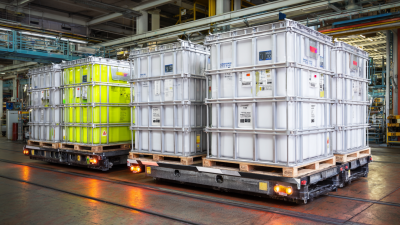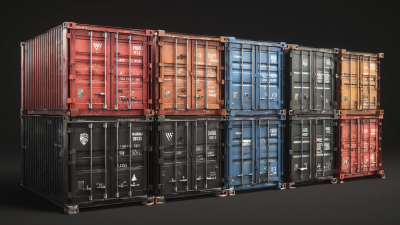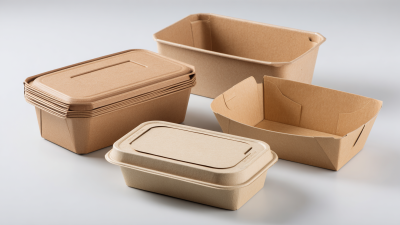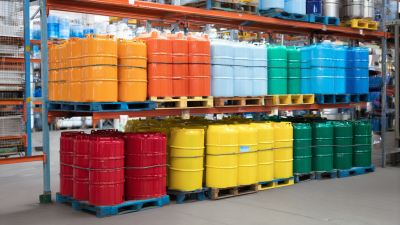
Blog
How to Select the Right Plastic Bulk Containers for Optimal Warehouse Efficiency
In the fast-paced world of logistics and warehousing, selecting the right plastic bulk containers is crucial for optimizing efficiency and reducing operational costs. According to a report by the Freedonia Group, the demand for plastic bulk containers is projected to reach $3.7 billion by 2025, driven by their durability, lightweight nature, and ability to streamline storage and transportation processes. As businesses increasingly recognize the benefits of using plastic bulk containers, it becomes imperative to understand the various options available and how they can best fit into an organization's workflow. This guide will provide essential tips to help you choose the right plastic bulk containers tailored to your specific needs, ensuring peak performance within your warehouse operations.

Understanding the Importance of Plastic Bulk Containers in Warehouse Operations
In modern warehouse operations, the role of plastic bulk containers cannot be overstated. These containers not only enhance storage capacity but also improve the overall efficiency of logistics processes. According to a report by Freedonia Group, the plastic bulk container market is projected to reach $9.5 billion by 2025, reflecting a compound annual growth rate (CAGR) of 4.9%. This increase is driven by the demand for reusable and durable storage solutions that reduce waste and optimize space utilization within warehouses.
Plastic bulk containers offer significant advantages over traditional packaging methods. They are lightweight yet sturdy, allowing for ease of handling and transportation. Furthermore, they can be stacked, which maximizes vertical space in warehouses. A study by Smithers Pira highlights that using plastic bulk containers can reduce shipping costs by up to 30%, underscoring their economic benefits. Additionally, their resistance to moisture and chemicals makes them ideal for various industries, from food and beverage to pharmaceuticals. By integrating the right plastic bulk containers into their operations, warehouses can not only streamline their workflow but also contribute to sustainable practices.
Key Factors to Consider When Selecting Plastic Bulk Containers for Your Storage Needs
 When selecting plastic bulk containers for your storage needs, there are several key factors to keep in mind. First, consider the size and capacity of the containers. It’s crucial to choose containers that maximize your warehouse space without compromising on accessibility.
When selecting plastic bulk containers for your storage needs, there are several key factors to keep in mind. First, consider the size and capacity of the containers. It’s crucial to choose containers that maximize your warehouse space without compromising on accessibility.
Measure your storage area and analyze your typical load volumes to determine the appropriate dimensions and capacity that will work best for your operations.
Another important factor is the material used in the containers. Different types of plastics offer varying levels of durability, resistance to chemicals, and temperature tolerance. For instance, high-density polyethylene (HDPE) is known for its strength and resistance to impact, making it ideal for heavy loads.
Additionally, think about features such as stackability and ease of handling. Stackable containers can significantly enhance vertical space usage, while ergonomic designs can improve safety and efficiency during loading and unloading processes. Ultimately, the right choice of plastic bulk containers can lead to streamlined operations and enhanced warehouse productivity.
Comparative Analysis of Plastic Bulk Containers: Strength, Weight, and Durability Data
When selecting the right plastic bulk containers for optimal warehouse efficiency, it is crucial to consider factors such as strength, weight, and durability. Recent trends in sustainable materials highlight that bioplastics, derived from renewable resources, are becoming a viable alternative to traditional plastics. These materials not only have a reduced carbon footprint but also offer comparable strength and durability necessary for bulk storage and transport. In addition, the movement towards biodegradable plastics signals a shift towards sustainability, emphasizing the importance of lifecycle assessments to evaluate long-term impacts.
Incorporating innovative technologies, like 3D printing, can further enhance the utility of plastic bulk containers. The upcycling of recycled plastics and biomass waste into sustainable composites allows businesses to tap into eco-friendly solutions without compromising on performance. Lightweight composite structures can improve operational efficiency in warehouses, making handling easier and reducing transportation costs. As companies strive for sustainability, understanding the comparative data on plastic bulk containers becomes an essential part of selecting the right materials that align with both operational needs and environmental responsibilities.
How to Select the Right Plastic Bulk Containers for Optimal Warehouse Efficiency
| Container Type | Material Strength (lbs) | Weight (lbs) | Durability (Cycles) | Dimensions (inches) | Capacity (gallons) |
|---|---|---|---|---|---|
| Heavy-Duty Container | 1,500 | 50 | 500 | 48 x 40 x 36 | 55 |
| Standard Bulk Container | 1,000 | 35 | 300 | 48 x 40 x 30 | 45 |
| Lightweight Container | 800 | 25 | 200 | 48 x 40 x 24 | 30 |
| Nestable Container | 600 | 20 | 150 | 48 x 40 x 18 | 25 |
Optimal Container Sizes and Shapes for Maximizing Warehouse Shelf Space Efficiency
When selecting plastic bulk containers for warehouse use, optimizing size and shape is essential for maximizing shelf space efficiency. Recent studies indicate that approximately 30% of warehouse space is underutilized due to poor container selection and layout design. To counteract this, adopting multi-tier racking systems can significantly enhance volume utilization, making it an ideal choice for accommodating various container shapes and sizes. Such systems offer flexibility in arrangement and can be tailored to specific warehouse needs.
Moreover, utilizing an AI-driven framework for automated warehouse layout generation can provide invaluable insights into how different container configurations affect workflow. By simulating various layouts, users can identify the most efficient use of available space, leading to a potential increase in productivity by up to 20%. This approach not only ensures that the right bulk containers are used, but also that they are strategically placed for easy access and optimal inventory management. As the industry evolves, integrating smart storage solutions will be key for staying ahead in the competitive landscape.
Optimal Container Sizes for Warehouse Efficiency
Cost-Benefit Analysis: Investing in Quality Plastic Bulk Containers for Long-Term Savings
When considering the cost-benefit analysis of investing in quality plastic bulk containers, businesses must look beyond the initial purchase price. According to a recent industry report by Grand View Research, the global plastic containers market is expected to reach $53.1 billion by 2025, highlighting a growing trend towards sustainable and efficient warehousing practices. By choosing high-quality bulk containers, companies can significantly reduce replacement costs and minimize downtime associated with damaged or inadequate storage solutions.
**Tip:** When selecting plastic bulk containers, prioritize durability and flexibility. Look for containers made from high-density polyethylene (HDPE) or polypropylene (PP), as these materials offer better resistance to impact and environmental stressors, enhancing the longevity of your investment.
Moreover, quality containers can lead to improved space utilization and organization in the warehouse. A study by the Material Handling Industry of America found that effective storage systems can increase space efficiency by up to 30%. This fact further emphasizes the importance of investing in containers that can optimize your warehouse layout and facilitate smooth inventory management processes.
**Tip:** Consider the stackability and nesting features of containers. This will not only save space during storage but also enhance ease of transportation, making your logistics more efficient. By considering these factors, businesses can enjoy long-term savings and improved operational efficiency.

Related Posts
-

Innovative Solutions for Maximizing Efficiency with Best Plastic Bulk Containers
-

Ultimate Guide to Sourcing Bulk Containers for Your Business Needs
-

Understanding the Technical Specifications of the Best Plastic Shipping Containers with a Comprehensive Tutorial
-

Revolutionizing Food Packaging Containers for 2025 The Ultimate Guide to Industry Trends and Innovations
-

Ultimate Guide to Specifications of the Best Plastic Bulk Containers for Global Buyers
-

Navigating Challenges with Plastic Bulk Containers: Common Issues and Solutions for Global Buyers
